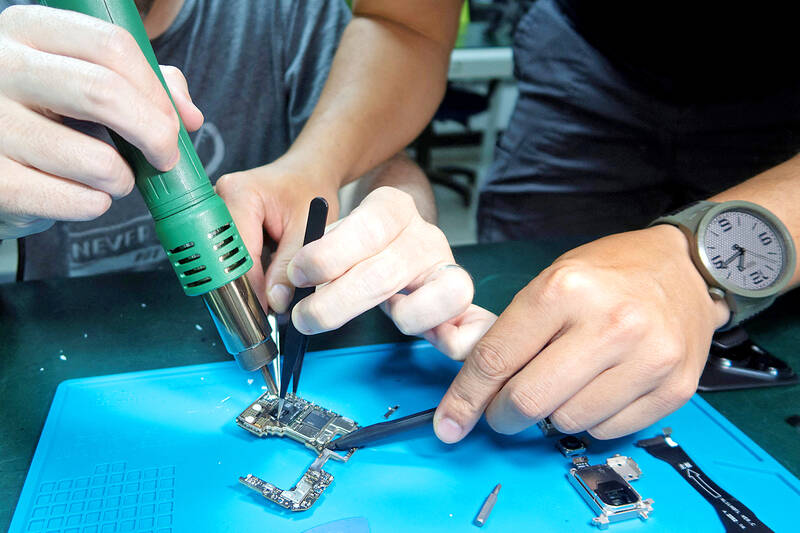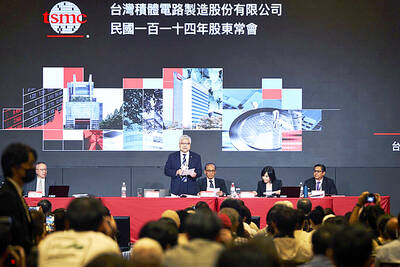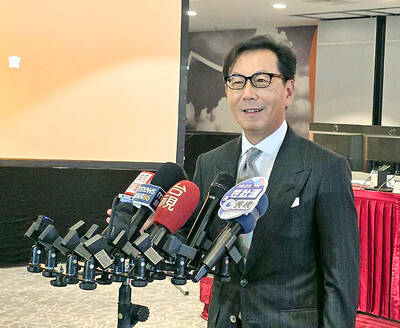Huawei Technologies Co’s (華為) latest high-end smartphone features more Chinese suppliers, including a new flash memory chip and an improved chip processor, a teardown analysis showed, pointing to the progress China is making toward technology self-sufficiency.
The inside of Huawei’s Pura 70 Pro was examined by online tech repair company iFixit and consultancy TechSearch International, finding components made by Chinese suppliers.
The firms also found that the Pura 70 phones run on an advanced processing chipset made by Chinese chip foundry Semiconductor Manufacturing International Corp (SMIC, 中芯) called the Kirin 9010, which is likely a slightly improved version of the advanced chip used by Huawei’s Mate 60 series.

Photo: Reuters
“While we cannot provide an exact percentage, we’d say the domestic component usage is high, and definitely higher than in the Mate 60,” iFixit lead teardown technician Shahram Mokhtari said.
“This is about self-sufficiency, all of this, everything you see when you open up a smartphone and see whatever are made by Chinese manufacturers, this is all about self-sufficiency,” Mokhtari said.
The Pura 70 series launched late last month and quickly sold out.
Earlier analysis by teardown firms such as TechInsights of the Mate 60, launched in August last year, found that the phone used DRAM and NAND memory chips made by South Korea’s SK Hynix.
SK Hynix said at the time that it no longer works with Huawei, and analysts said the chips likely came from stockpiles.
The Pura 70 still contains a DRAM chip made by SK Hynix while the NAND flash memory chip was likely packaged by Huawei’s in-house chip unit, HiSilicon (海思), with each NAND die bearing a 1-terabit capacity, iFixit and TechSearch found.
This is comparable to products made by major flash memory producers such as SK Hynix, Kioxia and Micron.
“In our teardown, our chip ID expert has identified it as a particular HiSilicon chip,” Mokhtari said.
The processor used by the Puro 70 Pro suggests that Huawei might have only made incremental improvements to its ability to produce an advanced chip with Chinese partners in the months since it launched the Mate 60 series, iFixit and TechSearch said.
The processor is similar to the one in the Mate 60 series, which used SMIC’s 7-nanometer N+2 manufacturing process, they said.
“This is significant, because news of the 9000S on 7-nanometer nodes caused a bit of a panic last year when US lawmakers were confronted with the possibility that the sanctions imposed on Chinese chipmakers might not slow their technological progress after all,” iFixit said.
“The fact that the 9010 is still a 7-nanometer process chip, and that it’s so close to the 9000S, might seem to suggest that Chinese chip manufacturing has indeed been slowed,” iFixit added.
Huawei should not be underestimated, as SMIC is still expected to make a leap to a 5-nanometer manufacturing node before the end of the year, Mokhtari said.

CAUTIOUS RECOVERY: While the manufacturing sector returned to growth amid the US-China trade truce, firms remain wary as uncertainty clouds the outlook, the CIER said The local manufacturing sector returned to expansion last month, as the official purchasing managers’ index (PMI) rose 2.1 points to 51.0, driven by a temporary easing in US-China trade tensions, the Chung-Hua Institution for Economic Research (CIER, 中華經濟研究院) said yesterday. The PMI gauges the health of the manufacturing industry, with readings above 50 indicating expansion and those below 50 signaling contraction. “Firms are not as pessimistic as they were in April, but they remain far from optimistic,” CIER president Lien Hsien-ming (連賢明) said at a news conference. The full impact of US tariff decisions is unlikely to become clear until later this month

Popular vape brands such as Geek Bar might get more expensive in the US — if you can find them at all. Shipments of vapes from China to the US ground to a near halt last month from a year ago, official data showed, hit by US President Donald Trump’s tariffs and a crackdown on unauthorized e-cigarettes in the world’s biggest market for smoking alternatives. That includes Geek Bar, a brand of flavored vapes that is not authorized to sell in the US, but which had been widely available due to porous import controls. One retailer, who asked not to be named, because

CHIP DUTIES: TSMC said it voiced its concerns to Washington about tariffs, telling the US commerce department that it wants ‘fair treatment’ to protect its competitiveness Taiwan Semiconductor Manufacturing Co (TSMC, 台積電) yesterday reiterated robust business prospects for this year as strong artificial intelligence (AI) chip demand from Nvidia Corp and other customers would absorb the impacts of US tariffs. “The impact of tariffs would be indirect, as the custom tax is the importers’ responsibility, not the exporters,” TSMC chairman and chief executive officer C.C. Wei (魏哲家) said at the chipmaker’s annual shareholders’ meeting in Hsinchu City. TSMC’s business could be affected if people become reluctant to buy electronics due to inflated prices, Wei said. In addition, the chipmaker has voiced its concern to the US Department of Commerce

STILL LOADED: Last year’s richest person, Quanta Computer Inc chairman Barry Lam, dropped to second place despite an 8 percent increase in his wealth to US$12.6 billion Staff writer, with CNA Daniel Tsai (蔡明忠) and Richard Tsai (蔡明興), the brothers who run Fubon Group (富邦集團), topped the Forbes list of Taiwan’s 50 richest people this year, released on Wednesday in New York. The magazine said that a stronger New Taiwan dollar pushed the combined wealth of Taiwan’s 50 richest people up 13 percent, from US$174 billion to US$197 billion, with 36 of the people on the list seeing their wealth increase. That came as Taiwan’s economy grew 4.6 percent last year, its fastest pace in three years, driven by the strong performance of the semiconductor industry, the magazine said. The Tsai